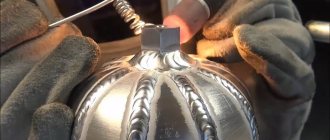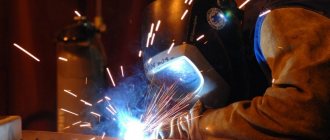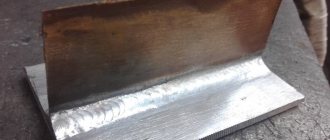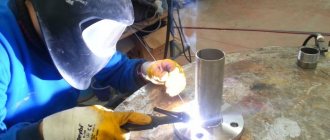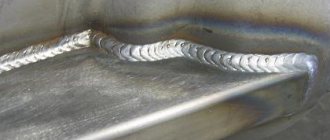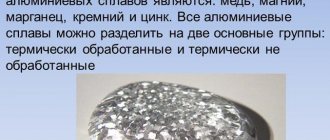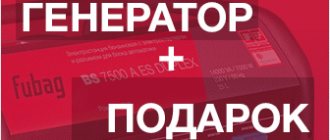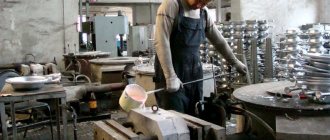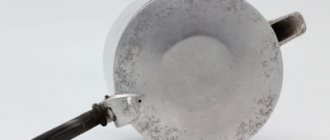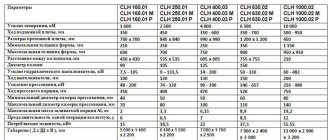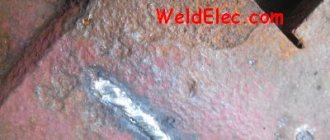Aluminum is not the most durable material, so it is not surprising that objects made from it often break. It is not necessary to take them to a workshop; you can repair them at home by welding aluminum with an inverter. However, to create reliable connections, you need to take into account the extraordinary properties of this capricious material.
Aluminum - properties and features
Due to its chemical and physical properties, aluminum is widely used in various fields of human activity.
For welding various structures or parts, not only aluminum, but also alloys made from it can be used. True, the process itself can only be done by experienced welders.
Because this metal is capricious, and in order to weld it efficiently, you need high qualifications.
Video:
The difficulties of welding aluminum are due to a number of characteristic features of the metal:
- High turnover. Under the influence of high temperatures, the metal loses strength and during the welding process, the molten part of the metal can destroy the lower, unmelted part. In this case, the aluminum will simply leak out through the seam. The difficulty of controlling the situation is aggravated by the fact that the color of the metal does not change when heated. Therefore, in order to maintain the shape of the weld pool, welders use special linings made of ceramic or metal;
- Formation of an oxide film. When interacting with oxygen, a film appears on the surface of aluminum, the properties of which differ from its properties in higher density and refractoriness. During welding, aluminum oxide prevents the metal from fusing into a monolithic seam. Therefore, it is removed using cathode sputtering. And in order to prevent the appearance of an oxide film, the welding area is protected from contact with air. For this, argon welding is used;
- With a sufficiently high coefficient of linear expansion, aluminum has a low elastic modulus, which can provoke deformation of the structure being welded. The likelihood of deformation can be reduced using various technological methods - electric welding in optimal mode or heating;
- The welding process contributes to the appearance of porosity in aluminum alloys. This happens because metal compounds contain hydrogen, which escapes through newly formed pores. Also, with an increased silicon content, small crystallization cracks may appear, which can significantly weaken the weld;
- Aluminum has high thermal conductivity. Therefore, to weld it, powerful sources of welding current are required;
- During welding, hot cracks may form in aluminum seams. This occurs due to processes of internal changes at the moment of solidification of the molten metal. To prevent their occurrence, special modifiers are used that are added to welds. Also, it is undesirable for the seams to be close to each other.
IMPORTANT TO KNOW: Manual arc welding technology for pipes
In addition, at home there are often cases when welding is applied to aluminum alloys of an unknown brand, which is not always feasible without special materials and special welding modes.
This is interesting: How to bend a profile pipe with your own hands at home
Metal preparation
Before connecting aluminum elements at home, the following steps are required:
- Clean metal parts from oxide deposits. Degrease surfaces with solvent.
- To obtain a strong, uniform seam, the edges of thick parts are cut at an angle of 45-60°.
- The electrode coating quickly absorbs moisture. Before starting work, they are calcined at a temperature of 200°C.
- The parts to be welded are heated to 250°C. This speeds up the process of destruction of oxide deposits.
We recommend reading Duralumin welding technology
Difficulties in welding aluminum products
Parts made of aluminum are coated with an oxide film, which has a high melting point of 2000 degrees Celsius. While the metal itself melts at 600 degrees. Therefore, before starting work, the film must be removed: chemically or mechanically. It is worth remembering that welding aluminum should begin immediately after removing the refractory film in order to avoid re-oxidation of the surface - this occurs when the metal comes into contact with oxygen contained in the air.
It must be taken into account that the strength of products decreases with sudden temperature changes. And due to the fact that the electric arc heats up to a high temperature, the aluminum melts and begins to flow out of the welding zone.
Additional complications are created by the fact that the color of the metal does not change when heated. Therefore, it is difficult to control that the weld is the same size throughout the entire area. The welded structure may change shape due to the low elastic modulus. For the same reason, when the product cools down, microcracks can form in the area of the weld pool.
Knowing about these difficulties, you can weld aluminum yourself using an inverter, without the help of specialists.
Welding requirements
Welding aluminum must strictly follow the following rules:
- Welding is carried out only under the protection provided by inert gases. As a rule, argon and its mixture with helium are used. Accordingly, the inverter apparatus must be equipped with argon arc welding equipment.
- It is better to use tungsten electrodes for aluminum - they do not melt. During work, you need to periodically clean off oxides from them, otherwise the quality of the seam will deteriorate.
- The work is carried out using alternating electric current, the strength of which is set greater than when working with steel products.
- To prevent the weld from deforming due to temperature changes, it is necessary to warm up the working surface before welding.
- Filler electrodes for aluminum are preheated by placing them in a muffle furnace.
Equipment for work
For welding aluminum or aluminum alloy workpieces can be used
inverter-type devices that differ in performance and degree of automation of work processes. If it is not possible to purchase a semi-automatic device, you can install an attachment to the inverter, which will generate alternating current. This will allow you to work efficiently.
In the case when aluminum is welded with a TIG inverter, non-consumable tungsten electrodes and filler wire with a diameter of 2-5 mm of several markings are used: AO, AD and AK. It contains a large number of magnesium alloy additives.
You can also use the following electrodes for welding aluminum with an inverter: Russian brands OZA, OZR OZANA; or imported samples of OK 96.20, OK 96.40, Kobatek-213 brands.
The wire for semi-automatic welding inverters for aluminum has a diameter of 0.8-1 mm. It is produced in reels that weigh half a kilogram. It is optimal to use wire made of lithium-silicon alloy of two grades - ER 4043 and ER 5356. Or wire grades made of magnesium alloy with aluminum - Sv-AK 5 or Sv-AMg 5.
The argon arc (AC TIG) method of welding aluminum parts is mainly used for detailed welding. As a result, no pores or rough seams are formed. Alternating current allows you to melt the refractory oxide layer on the surface of the material and create a weld pool, which is necessary for connecting structural elements. When using a device of this type, it is possible to repair thin-walled products made of pure metal and its alloys. However, it is quite sensitive to contamination of the electrodes used - for this reason, they must be cleaned in a timely manner.
Electrodes for aluminum
The most common brands of electrodes for welding aluminum alloys: OZA-1, OZA-2, OZANA-1, OZANA-2, OK96.20. Electrode rods are made from welding wire and coated with a mixture of chloride and fluoride salts. The coating thickness is no more than 0.3...0.5 mm per side.
Electrodes for aluminum OZANA-2
Let's consider a more detailed purpose of each electrode.
- OZA-1 - for parts and structures made of technically pure aluminum A0, A1, A2, A3. Welding with preheating along cleaned edges.
- OZA-2 – for welding casting defects and surfacing aluminum-silicon alloys AL-4, AL-9, AL-11.
- OZANA-1 - welds technically pure aluminum with a thickness of products more than 10 mm. Preheating at a temperature of 250…400 C.
- OZANA-2 – for AL-4, AL-9, AL-11 alloys, surfacing and welding of casting defects. Can be used as a connecting material for products made of duralumin and silumin.
- OK96.20 – aluminum-manganese alloys AMts; aluminum-magnesium alloys AMg2; AMg3; AMg5; AMg6; aluminum-silicon alloys AL-4; AL-9; AL-11. Suitable for duralumin
Aluminum electrodes are more expensive than conventional electrodes and are very hygroscopic, i.e. they absorb moisture from the surrounding air.
Instructions for performing the work
Aluminum welding with an inverter is carried out according to a strict algorithm.
First of all, the machine for inverter welding is set up. The toggle switch is switched to alternating current mode corresponding to the AC value. The next step is to set the polarity balance to a value - when working with products made of pure aluminum, it must be shifted from the original position (50/50) to the negative side, and when welding alloys - to the positive side. The value of the welding current is set depending on parameters such as sheet thickness and electrode diameter. For example, with a sheet thickness of 2 mm and a filler wire diameter of 3 mm, it is set to a value of 60 Amperes.
The thickness of the product also determines the slowing down of the attenuation of the electric arc to fill the crater at the end of the weld pool. So, when working with a 2mm sheet, this value is set to 3 seconds.
The settings of the welding inverter for aluminum welding are completed by setting the time and intensity of purging the seam with an inert gas (it is impossible to work without argon), which is required in order to cool the weld seam.
After setting up the equipment, it is necessary to prepare the workpiece itself - clean it of the film that increases the heat resistance of the material. Both mechanical cleaning (iron brush, sandpaper) and chemical cleaning are used. In the latter case, an aqueous solution of zinc chloride or another solvent is used. Then the product must be preheated to 400 degrees. Only after this can you proceed to finishing welding work. You should act slowly so that the elements being welded are heated with the same intensity.
In order for the resulting weld to be uniform with characteristic ribbing, the filler wire or electrodes on aluminum for welding must be applied with light touches at a certain angle - 15 degrees, starting from the beginning of the weld pool. In this case, several passes are made along the seam.
Thus, if you have the necessary equipment, you can weld aluminum products conscientiously at home using an inverter. It is important to consider that beginners should not immediately perform finishing work. First, it is better to train under the supervision of a specialist in order to acquire the necessary skills and experience in performing such operations.
You can see the aluminum welding process in the video:
Necessary equipment
It is logical that to carry out work of this kind, the use of equipment is mandatory. First of all, it is necessary to ensure suitable conditions and prevent the occurrence of traumatic situations.
Moreover, it is necessary that this equipment helps control the energy transformation process.
For welding using gas, you will need an element with a gas supply, a cylinder with the necessary gas, a reducer and gas hoses.
What parameters are set depending on the thickness of the metal being welded?
When setting up the welding machine, you must perform the following manipulations:
- adjust the AC balance (plus or minus) . Typically, when welding aluminum, reverse polarity is used, that is, “-“;
- adjust the welding current depending on the thickness of the elements being connected . The pulse current increases with increasing thickness of the parts being welded. So, for aluminum with a thickness of 1 mm, a current of 23 to 27 Amperes is used, and for welding aluminum with a thickness of 5 mm - 150-180 Amperes;
- adjust arc attenuation, which also depends on the thickness of the parts : the thicker, the longer. For example, to connect aluminum with a thickness of 2 mm, it is enough to set this parameter for 3 seconds;
- set up gas purging for cooling (if such a function is available).
Inverter for welding
Inverters used for welding aluminum parts may differ in design and modification. The most common are semi-automatic devices, as well as electric arc installations.
The machine selected for welding aluminum parts must have the following capabilities:
- an oscillator must be installed to provide the possibility of increasing the starting current;
- adjustment of the main current with high accuracy in accordance with the thickness of the part;
- inert gas supply regulator for welding operations.
Approximate cost of inverters for welding on Yandex.market
Features of the technology
Let's look at the features of aluminum electrode welding technology. Manual arc welding of aluminum is not the most convenient process, so it is important to know and take into account some features of welding.
- Selection of electrodes . First of all, you need to select the appropriate type of electrodes. The fact is that some brands have a coating intended only for working with aluminum alloys. Others are used exclusively for welding pure aluminum. Therefore, this parameter should be taken into account. Electrode manufacturers indicate the purpose of a specific brand, so you can easily choose the right one.
- Surface cleanliness . When welding with electrodes, preparation of the surface of the structure is of great importance. It should be well processed so that the seam is smooth and durable.
- Current _ Aluminum welding is carried out using direct current of reverse polarity. This is due to the fact that an oxide film forms on the surface of this metal. And with reverse polarity, the film is destroyed using cathode sputtering.
Chemical properties of aluminum
Aluminum is characterized by high solubility of hydrogen in liquid form with low solubility at the crystallization point. This directly affects the quality of welding work. If even a small amount of hydrogen dissolves in the weld metal, the weld may become porous , as the hydrogen will tend to escape.
Another important chemical property of aluminum is oxidation . The combination with oxygen creates aluminum oxide, which forms a kind of film on the surface of the metal. On the one hand, the oxide film reliably protects the metal from corrosion. On the other hand, it becomes an obstacle to welding work . Despite the fact that aluminum melts already at 660.3
O
C, melting temperature of the oxide film - 2037
O
WITH.
Mechanical properties of aluminum
The strength, elasticity and elongation of the weld depend on the type of alloy from which the parts are made, as well as on the composition of the electrode. The strength of the welded joint will be quite weak in cold-hardened alloys. To achieve good weld strength in heat-resistant alloys, longer heat treatment times and slow cooling are required.
IMPORTANT! Aluminum has good thermal conductivity, so it is recommended to use heat-dissipating pads when carrying out welding work. This will help preserve the remaining parts of the workpieces from shrinkage and deformation.
Use of alloying components
To improve the quality of the weld, the following alloying additives can be used in aluminum electrodes:
- Manganese (Mn) - increases corrosion resistance.
- Silicon (Si) - reduces the melting of aluminum, improves fluidity and weldability.
- Magnesium (Mg) - gives the metal excellent weldability and good strength. When combined with silicon, it forms a heat-resistant alloy.
Electrodes OK AlMn1 (96.20) containing manganese
This is interesting: Do-it-yourself electroplating at home: technology and equipment
Safety precautions
This type of activity belongs to the group of trauma-hazardous processes. Therefore, you should strictly follow the prescribed rules to avoid causing harm to others.
It should be remembered that:
- The specialist must wear: a special suit, a mask, thick gloves, shoes with rubber soles;
- The electrical circuit must be isolated and inaccessible;
- Welding can only be carried out in clean areas. It is prohibited to carry out work in the presence of flammable objects;
- The work area must have good ventilation to avoid gas poisoning.
What do you need to know to make a quality seam?
To obtain strong and durable connections, you need to know and consider the following points:
- products made of aluminum alloys are always coated with a layer of refractory oxides;
- before starting welding, this layer should be removed by mechanical stripping or etching;
- the oxide layer is quickly restored in air, so the treatment must be carried out immediately before welding;
- the color of the aluminum billet practically does not change when heated, it will not be possible to monitor the temperature visually;
- When heated, the strength of the product decreases, this can lead to the appearance of microdefects during crystallization.
Taking these features into account allows you to avoid common mistakes when you need to weld aluminum blanks at home.
Difficulties of the process
Let's look at the complexities of the electrode welding process on aluminum. The difficulty of manual welding of aluminum structures is largely due to the properties of this metal. Below are examples of the main problems that may arise during the welding process.
- High metal fluidity . Molten aluminum is difficult to control. With significant overheating, the behavior of the metal becomes somewhat unpredictable. The melt can destroy the layer of solid metal underneath and flow out through the crack. To solve this problem, it is recommended to use ceramic or refractory steel gaskets .
- Oxidability of aluminum . The main problem of aluminum products. Combining with oxygen, metal molecules form a dense oxide film. It is stronger than the metal itself and melts only at very high temperatures. Another disadvantage is that the film is a dielectric, so it is difficult to ignite an arc. To solve this problem, you need to thoroughly clean the metal working surface before welding .
- High coefficient of linear expansion. Aluminum is quite fragile and has low elasticity. When the metal is very hot, the welding zone puts pressure on the rest of the structure, which can cause cracks or deformation of flat surfaces. To avoid this, you need control welding temperature. Better yet, preheat the part to 200-250
OWITH.
- When the weld metal hardens, it can crystallize and hot cracks appear . Therefore, it is advisable to add a special filler material. This is especially necessary in cases where several seams are located at a short distance from each other.
Useful video
Watch the video where the craftsman argues that welding aluminum with an electrode is not the best solution and demonstrates the process clearly, with explanations.
Manufacturing instructions
It doesn't matter what brand of electrodes you need to purchase, in any case it is not cheap. Especially for beginner welders. We have found a solution to this problem and suggest you make the rods yourself. There are many videos on the Internet in which experienced craftsmen explain the technology for making materials for welding. We also decided to share our instructions on how to make homemade electrodes with your own hands. Follow these simple steps:
- Prepare aluminum wire with a diameter of no more than 4 millimeters and cut it into rods 20-25 centimeters long. These parameters are usually sufficient, but you can change the diameter and length as you wish. Our base is ready.
- Now let's prepare the coating. Grind up chalk (preferably regular white) and mix it with silicate glue (sometimes called “liquid glass” in stores). Mix everything thoroughly until smooth and dip the aluminum rods into it.
- Make sure that the coating layer does not exceed 2 millimeters. Leave the electrodes to dry. When the coating hardens, the rod can be used for work.
Yes, such electrodes for resistance welding are inferior in quality to factory products, but they still allow you to perform simple work that does not require increased responsibility and a perfect seam. This instruction may seem too simple, but believe me, electrodes for spot welding on your own can also be effective and will absolutely save your money.
Please note that this is not a factory carbon electrode or zinc electrode, it is not European quality. So test your electrodes first before working on unwanted metal.
How to cook correctly: technique, stages and nuances
Now let's figure out how to weld aluminum structures using conventional coated electrodes, and what is required for this.
First stage: preparatory
Before starting welding, it is necessary to carry out preparatory work to clean the surface from dirt and oxide film. This is necessary in order to ensure good weldability of the metal and the formation of a high-quality seam. Sequencing:
- Pre-cleaning . Any detergent + stiff brush. The metal is then washed with clean cold water.
- Then the surface needs to be degreased . Organic solvents are suitable for this: white spirit, acetone, etc.
- If the part is small, it You can put it in an alkaline bath for a few minutes. The solution temperature must be greater than 60
OWITH.
- After this, the surface must be sanded with a wire brush . Do not use abrasive agents, as particles of the working layer may remain on the surface.
- The metal is then washed with a solvent . It cannot be wiped off, must dry on its own.
Video
In the next video, the master welds a bicycle stand with Zeller-480 electrodes.
NOTE! It is recommended to calcinate aluminum electrodes before use. The optimal calcination mode is 2 hours at a temperature of +200
O
WITH.
Welding techniques and nuances
When welding with electrodes, you need to use direct current of reverse polarity . The current strength depends on the thickness of the electrode. It is calculated as follows: per 1 mm of electrode there should be a current of 20-25 amperes.
In order for the seam to be of high quality, the working surface of the part should be heated to a temperature of 300-400
O
C. This will help prevent hot cracking and also reduce the risk of material deformation.
The electrode must be held vertically, but can be tilted slightly . The end of the rod should be moved in the direction of the seam . It is recommended to weld in one pass on a short arc, without making transverse movements.
If the arc breaks the slag crust must be removed from the crater on the working surface and from the end of the electrode . Then you can continue working. After welding is completed, the resulting seam should be cleaned of slag formations and washed with water .
IMPORTANT! Aluminum electrodes melt 2-3 times faster than conventional ones. Therefore, when we weld aluminum with electrodes, it is recommended to weld with one electrode continuously until it completely melts.
Find out more about electrodes for aluminum here. Where to buy electrodes for aluminum.
